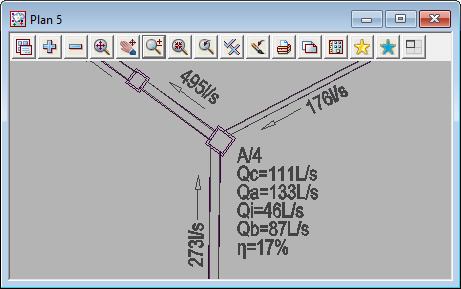Excess Flow – Hydraulics for the Rational Method
Excess flow (Qx) occurs when more water arrives at a node than the downstream link (pipe) can carry.
Or to put it another way: the pipe taking water away from the node is too small.
Excess Flow in your network must not be ignored.
You MUST deal with any Excess Flow
12d Model will warn you when Excess Flow occurs, the Problem message is sent to the output window

The full message is:-
PROBLEM: Pipe “A/4” to “A/3” – US pit HGL of pipe reached the network minimum upstream grate level(see Qx messages above for location).
Unable to re-route excess pipe flow (Qx) of 0.0602 cumecs in pipe … All flow forced into pipe and the US pit and pipe hgls will be greater than that reported
You can remove excess flow from the network by either:
- Increasing pipes size (12d Model can do this for you automatically) or
- Sending the excess water to the overland flow system (ie you must provide an overland flow system).
How 12d Model deals with Excess Flow when pipes are too small
If the underground system is too small to carry the flow, the Excess Flow is handled in one of two ways (depending on whether there is an overland flow system)
- If there is a bypass node (ie an overland flow route), the ‘Excess’ water (Qx) is removed from the node sent to the bypass route. This is called ‘Qx Routing’.
Qx Routing is discussed below. - If there is no bypass node, then the ‘Excess’ water is forced through the pipe, and arrives at the next downstream node. This is done so that water is not ‘lost’ from the network.
A warning is sent to the output window.
Plan plots will show (in red) Qx=XXXL/s
If this is occurring in your model, then you must deal with it by either increasing link sizes, or adding bypass flow routes, or both.
This situation is not discussed further in this post.
Qx Routing
If a bypass route has been provided for the node, then Excess flow is added to the bypass from the node.
Two situations can be considered, one where the node can capture some of the approach flow before the node is full, the other where none of the approach flow is captured, and the pit may be surcharging.
1. Reduced Capture

In the network shown above, pipe flow into A/4 is 176 l/s and 273 l/s
The maximum pipe flow out of A/4 is 495l/s, and this occurs when the HGL at the node reaches the grate level (ie the pit is full)
The rating curve for the proposed grate and lintel shows that the node could capture 274l/s, but this could only occur if the underground network had greater capacity.
The efficiency of the pit has been reduced to 17% so that the amount captured is only 46l/s.
The annotation at the node is:
- Qc = Catchment flow
- Qa = Approach flow
- Qi = Inflow (note that for node A/4 the inflow is negative – ie it is outflow)
- Qb = Bypass flow
- Efficiency
2. Surcharge

In the network shown above, pipe flow into A/4 is 176 l/s and 279 l/s
Pipe flow out of A/4 is 155l/s, the remaining 300 l/s is surcharging at the node.
Qx Routing Increment
The calculation of how much water will be routed to the bypass channel is not deterministic, and 12d Model uses an iterative process to calculate the routing.
The process is
- Hydraulic calculations are done to determine the HGL at each node on the network based on the pipe flow. Nodes that have water above the grate level are identified.
- The most upstream of these is considered, and a quantity of water is routed to the bypass channel. This reduces the pipe flow from that node.
The two steps are repeated until the HGL at all pits is below the grate level.
The amount of water that is removed from the node at each iteration is the Qx Routing Increment.
The default volume for Qx is 10l/s (0.01 cumecs). This is considered a reasonable value.
For large networks with Excess Flow in numerous locations, the runtime may be excessive.
Increasing the value of Qx will improve runtime, but will result in a loss of accuracy.
As an example, the results shown above were obtained using Qx=10l/s.
Increasing Qx to 100l/s reduces runtime, but increases Qi from -300l/s to -332l/s
Further reading: 12d Model – Hydraulics for the Rational Method – Excess Pipe Flow